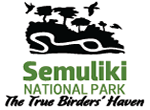Semuliki National Park contains approximately 441 confirmed bird species. Of these, over 35 are considered Congo biome endemics. The park is designated as an Important Bird Area by BirdLife International. Most records concentrate along the Kirumia Trail and Sempaya sector.
The Nkulengu rail (Himantornis haematopus) represents a priority species for visiting ornithologists.
It inhabits dense undergrowth and emits loud, rasping calls at dawn and dusk. These calls resemble harsh rhythmic croaks and often last over 30 seconds.
Visual sightings are rare, but acoustic detections are frequent. Researchers recommend early arrival at the Sempaya trailhead during wet months.
White-crested hornbills (Tropicanus albocristatus) fly in groups of three to six. They prefer mid-canopy levels and emit deep, drumming calls.
Their long tails and slow wingbeats assist identification during flight.
The African piculet (Sasia africana) occurs in vine tangles and lower branches. Observers should listen for rapid tapping sounds, which resemble those of a small woodpecker. Spotting this species requires patience, as it avoids open perches.
Western bronze-naped pigeons (Columba iriditorques) feed on fruiting trees above 20 meters. Their calls are low and repetitive, often mistaken for distant mammals.
In addition, the yellow-throated cuckoo (Chrysococcyx flavigularis) is occasionally heard near forest gaps.
Birders focusing on swamp specialists should visit the Semuliki River floodplain. Hartlaub’s duck (Pteronetta hartlaubii) and the white-bellied kingfisher (Corythornis leucogaster) have both been photographed there.
Observation requires stillness and narrow-field binoculars due to the habitat’s visual complexity.
Species count varies with season. During April and November, migratory movements increase diversity.
However, heavy rainfall reduces trail access. June and January offer a balance between access and vocal activity.
